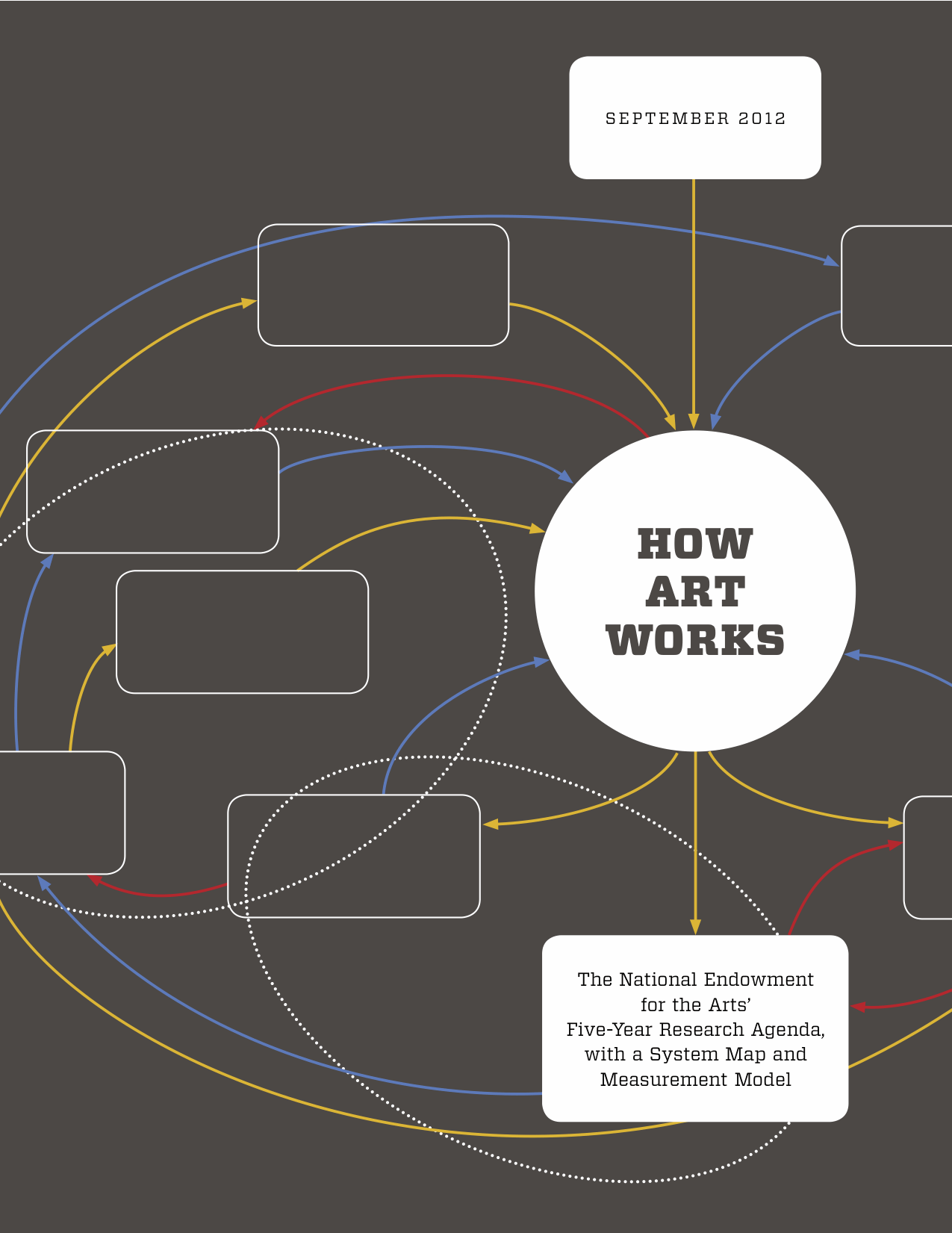
(For a brief summary of this article, check out “How Art Works: the I’m-late-for-work version.”)
With “How Art Works: The National Endowment for the Arts’ Five-Year Research Agenda,” the National Endowment for the Arts is getting proactive. Acknowledging that the NEA’s research efforts have been mostly descriptive in the past, “How Art Works” is intended to usher in a new era of strategic inquiry for the agency and the sector alike.
Released in September 2012, “How Art Works” “stems from a collaborative research inquiry.” Over the course of ten months prior, the NEA’s Office of Research and Analysis and the global consulting firm Monitor Institute conducted interviews and solicited input from a host of people inside and outside the arts sector. (A full list of thought partners is included in Appendix B.) The resulting report lays out a conceptual framework that is meant to aid in the planning and assessment of the NEA’s research priorities from 2012 to 2016, and to facilitate reporting to the White House Office of Management & Budget, Congress, and the public on the Endowment’s progress.
Summary
The practical goal of “How Art Works” is actually broader than this: beyond a research agenda for the NEA itself, it “proposes a way for the nation’s cultural researchers, arts practitioners, policy-makers, and the general public to view, analyze, and discuss the arts as a dynamic, complex system.” The strategy involves stating “feasible, testable” hypotheses about all manner of arts-related impacts on individuals and society in the form of a system map. The map in turn is intended to provide a theory of change to guide arts research and to facilitate field-wide investigation and discussion.
Mapping the Impact of the Arts
The fundamental hypothesis of “How Art Works” is as follows:
[E]ngagement in arts contributes to quality of life. Quality of life contributes to society’s capacity to invent, create, and express itself. This capacity contributes back to art, both directly and indirectly.
The effects of engagement in the arts are cyclical and reciprocal, inherent and instrumental, and can be seen in artists, participants, and society at large.
To specify and organize the range of possible interactions, reactions, and transactions, the major feature of “How Art Works” is a system map, a visual representation of the parties and forces at play. According to Innovation Network, “this approach involves first visually mapping the system of interest and then identifying which parts and relationships are expected to change, and how.” A system map facilitates discussion with the goal of getting everyone on the same page.
In the “How Art Works” system map, the major components of the arts ecosystem are represented as “nodes” connected by arrows representing the relationships between those nodes.
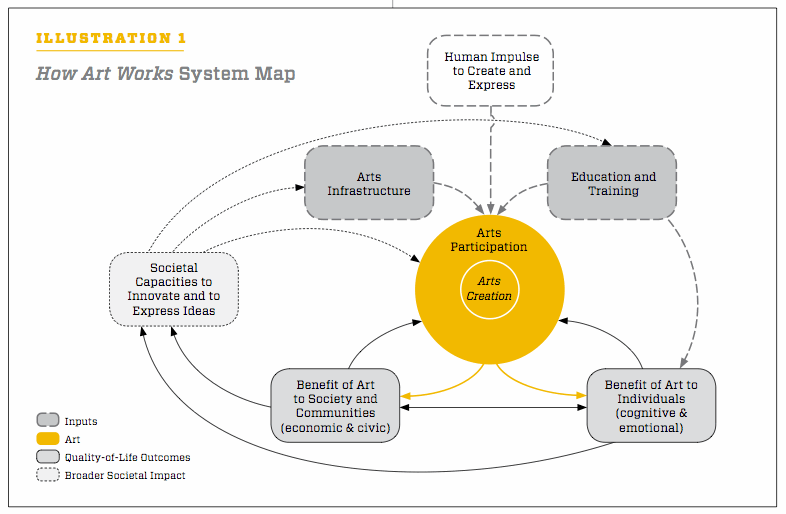
The map’s starting point – the Big Bang for the entire arts ecosystem as we know it – is the “human impulse to create and express.” This impulse is the motivation to experience or participate in artistic creation. The rest of the nodes on the map spring out of this drive and fit into four broad categories: Inputs, Art itself, Quality-of-Life Outcomes, and Broader Societal Impacts. In order to clearly define each node on the map, “How Art Works” includes a graphic representation of what the authors call a “Multi-Level Measurement Structure” for each component or variable within the main nodes, which will inform the measurement model for future research involving each part of the system. For example, here is the Measurement Structure for one of the two system Inputs, education and training:

Each Measurement Structure includes a list of “definitional questions and methodological challenges” (not pictured here), which are designed to help readers imagine how one might effectively gather data on all of these various and in some cases slippery concepts. Challenges include things like “insufficient data available,” difficult-to-isolate factors of change, or the limitations of prior research.
To summarize the map, we’ll walk through each of the nodes within the four main categories and briefly touch on the methodological challenges and observations on potential future research.
Inputs. According to “How Art Works,” the translation of the universal impulse to express into actual artistic activity depends on two Inputs, education and training and arts infrastructure.
Education and training represents all manner of arts learning opportunities, “from YouTube and street jam sessions, to K-12 and adult arts education, to apprenticeships and conservatory training.” It is education, both informal and formal, that allows for skillful expression of ideas for artists and develops a stronger sense of personal taste for arts consumers.
Arts infrastructure is described as the “institutions, places, spaces, and formal and informal social support systems that facilitate the creation and consumption of art.” These support systems include venues, organizations, schools, networks, unions, and associations, as well as less concrete elements like financial and volunteer support and public policy. Of course, the quality of available infrastructure matters as much as the quantity.
Art. Given the initial spark to create and the infrastructure and training to fan the flame, the next category is the Art itself. The artistic product, represented on the map by the yellow circle, has two sub-categories: creation and participation. Arts creation is the production of an artistic work within an established or emerging set of artistic principles with “the intention of communicating richly to others.” Arts participation includes creation but extends more broadly; it is defined as “the act of producing, interpreting, curating, and experiencing arts… and the consumption of these outputs.”
Finally, we move on to outcomes of the art, of which there are two types included as part of the map: Quality-of-Life Outcomes (so-called first-order outcomes) and Broader Societal Impacts (second-order outcomes).
Quality-of-Life Outcomes. Quality-of-life outcomes are the direct effects of interaction with the arts on individuals and communities. The report acknowledges that these outcomes could be positive or negative, though the word “benefit” is consistently used to describe them. The two nodes in this category are:
- The benefit of art to individuals, and
- The benefit to society and communities.
The outcome called the benefit of art to individuals encompasses the “cognitive, emotional, behavioral, and physiological effects” on participating individuals over time.
The second outcome, benefit to society and community, is farther-reaching than the first. This node encompasses “the role the art plays as an agent of cultural vitality, a contributor to sense of place and sense of belonging, a vehicle for transfer of values and ideal, and a promoter of political dialogue.”
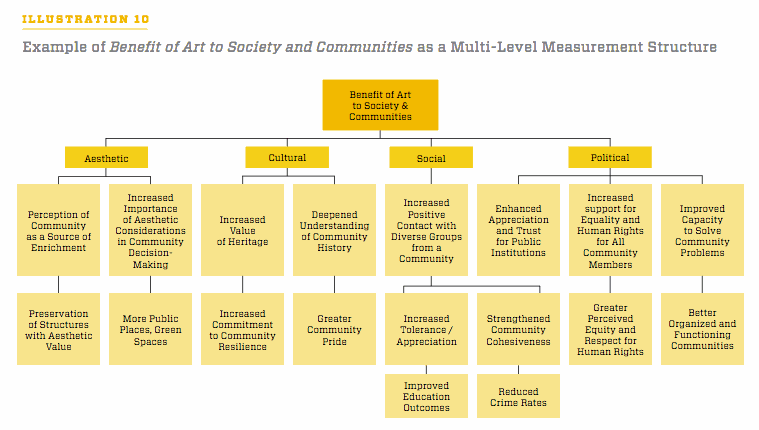
The report points out a few definitional questions, methodological challenges, and issues for further exploration to keep in mind with these Quality-of-Life Outcomes:
- In current research many of these effects are intertwined and overlapping. Determining what can be isolated and tested will be an important step in illuminating these outcomes.
- One complication when measuring the benefit of art to individuals is the uneven distribution of participation in arts activities. Presumably some people who like the arts like them a lot and choose to engage deeply and consistently, whereas others may never feel compelled. This is a methodological challenge because it makes data about impact difficult to generalize across the entire population.
- It is unclear whether the impact of the arts on children versus adults is different enough to demand separate evaluation strategies.
Broader Societal Impacts. The final node of the system map represents the second-order outcomes on society at large. A more detailed version of the map (immediately below) shows three new elements within this category:
- societal capacities to innovate and express ideas,
- new forms of self-expression, and
- outlets for creative expression.
These outcomes are included as “works in progress” in the report, which declines to offer a measurement structure for any of them. The latter two in particular are moving targets, as new art forms, techniques, and platforms continue to emerge; the authors cite platforms such as YouTube and Facebook and forms of expressions like data visualization as examples.
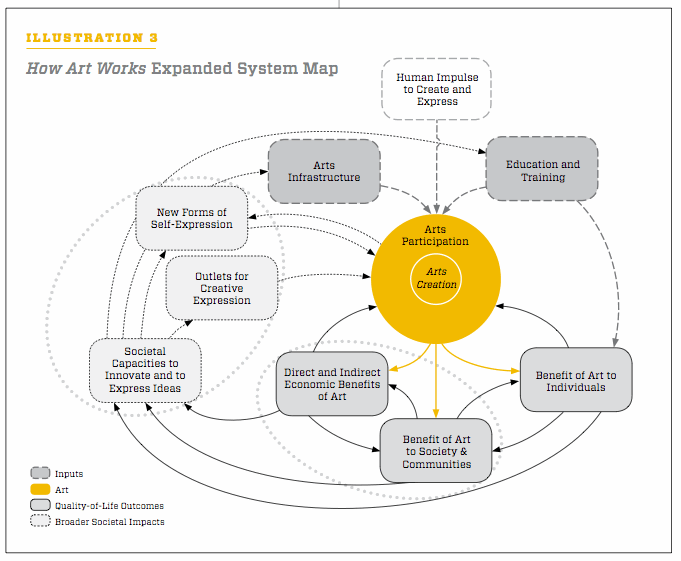
System Multipliers. Beyond the nodes themselves, the authors posit that certain forces act on all of the various components of the system to varying degrees, all at once, to affect the system’s environment. These so-called System Multipliers are like societal weather. They don’t necessarily change what you’re going to do in a day, but they might change how you do it, or how long it takes.
There are five multipliers proposed: markets and subsidies, politics, technology, demographics and cultural traditions, and space and time. It’s easy to imagine how these forces could shift the arts sector in big and small ways. Technology, for example, has completely changed the way we share and consume art. It has also changed the ways artists get compensated for their work, for better or worse, in ways many did not see coming even five years ago.
Obviously, the reach of these multipliers is vast. The authors explain at a high level how each multiplier could affect the arts sector, but do not provide insights on potential research applications beyond suggesting they be periodically tracked using evidence from individual research projects.
Shaping the Research to Come
In the final section of “How Art Works,” the authors assess to what extent the NEA’s current research priorities square with the hypotheses represented in the map. These pages feature a list of priority projects initiated or planned by the NEA’s Office of Research and Analysis over five years beginning in 2012, with each project keyed to an element of the map.
After reviewing the opportunities and potential areas of emphasis, the authors call attention to “a research gap associated with the nodes and relationships on the left side of the map: Societal Capacities to Innovate and to Express Ideas, and, in the expanded version of the map, New Forms of Self-Expression and Outlets for Creative Expression.” These nodes “mark a vast unsettled terrain” that “ultimately may hold the most promise and profit for those seeking to measure arts-related impacts.” Despite this promise, however, “How Art Works” notes that “most of the NEA’s research agenda for the next five years will continue to focus on arts infrastructure, education/training, arts participation and creation, and individual and community-level benefits,” areas where the NEA already has significant investment. The reasoning is that there are gains to be made in the short term by building on recent findings about Inputs and the benefit of art to individuals.
The report encourages the NEA to decide whether the rapidly-evolving “work-in-progress” elements outlets for creative expression and new forms of self-expression, as well as the catalyst of the system, the human impulse to express and create, are areas the Office of Research and Analysis can address in the next five years, or whether others will need to take the lead. “A reasonable approach might be to lodge these concepts in the broader dialectic of the arts research community, so that new hypotheses, research questions, populations, data sources, and methods might be proposed by groups outside the NEA.”
Finally, the authors point to the need to strengthen structural support for this research, for example through the NEA’s ongoing efforts to partner with other federal agencies for both program delivery and data collection. These priorities include “a clear need to build national time-series (preferably longitudinal) data collections including arts variables.” Additionally, over the next few years the NEA’s Office of Research and Analysis plans to consolidate arts-related data and make it publicly available to other cultural researchers.
Analysis
“How Art Works” does a good job of defining a reasonable and comprehensive model of the arts’ impact against which to consider the NEA’s own research efforts. However, the report is a bit like an impressionist painting: from far away it looks complete, but when you get close, individual features are hard to make out. It is a step forward to be sure, but its broad-brush approach and failure to build explicitly on past attempts, combined with a few untended loose ends, represent a missed opportunity to be a watershed for cultural researchers.
The Necessary Specificity
”How Art Works” is certainly not lacking in grand designs. A map of any sector from public agencies to individual consumers that fits within a report as short as this one is inevitably going to work at a high level. But there are times when the map’s lack of specificity and detail seems to call into question its value entirely. Take, for example, Illustration 5 (the second image above), the Measurement Structure for education and training. This diagram divides all of arts education and training into two sub-categories – arts subjects and non-arts subjects – and then further divides those into art itself and evaluation of art, then further into modes of instruction, and finally into discipline “types” being studied.
This framework is frustratingly generic. Arts education is an area we actually know quite a bit about. There are professional associations representing every corner of the field, from in-school arts teachers to community-based organizations to art therapists. There’s even the National Center for Creative Aging, which has a bird’s-eye view of current trends in arts education for older adults. The NEA’s own prior research is especially strong in this area, though this isn’t reflected in the text or the diagram. At some point in the process of making this and other models widely applicable, specificity – and with it utility – have been somewhat lost. If the goal is to direct further research, the system map should take full advantage of the knowledge we have already.
Doing so might have pointed out areas where the frameworks don’t quite make sense, even at the very high level on which they operate. For example, the generic language of “art as a subject” and “art in non-arts courses” brings to mind child-age learners in school settings. This seems a strange choice, since education and training according to the authors is meant to include arts learning in informal settings for learners of all ages. It may be that the map needs to be generic for universality, but it certainly shouldn’t implicitly narrow the field with imprecise language.
The audience for How Art Works is described briefly as “researchers, practitioners, policy-makers in the arts and in other sectors.” But this lack of specificity serves neither experts in the field, who are offered scant new insights into their focus areas, nor those less familiar with the arts, who will glean only the most general outlines of the work involved, even for well-established fields of practice like arts education. For those completely oblivious to the arts sector and all of its components – those who have never considered the connection between a community dance studio, what goes on inside the walls of the Kennedy Center, and, say, the economy – this report could be educational, but only to a point. Some nodes are more instructive than others. Benefit of art to society and communities for example (pictured above), could enlighten and spur new thinking for people who don’t spend all day dissecting the impact and values of the arts. But education and training wouldn’t provide much information for people who don’t already know what arts education looks like in all of its various forms.
Building on Prior Work
As a framework for understanding the effects of the arts, “How Art Works” misses important chances to incorporate and build on prior work like Gifts of the Muse. Published in 2005, Gifts is an extensive literature review that attempts to compile all of the various claimed benefits of the arts to individuals and society and evaluate and connect them in one text. It details the intrinsic benefits (captivation, pleasure, expanded capacity for empathy, cognitive growth, creation of social bonds, expression of communal meaning) and instrumental benefits (attitudinal, behavioral, health, community, economic) of the arts, assesses the available evidence, and makes recommendations on how to fill some of the gaps. Like “How Art Works,” Gifts constructed a working model of the benefits of the arts, the summary version of which is pictured here:
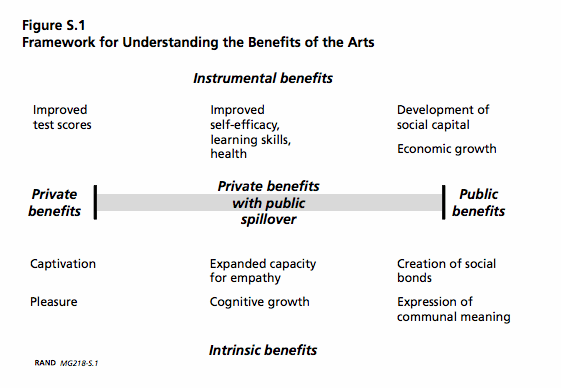
A few years before Gifts, the Cultural Dynamics Project (a collaboration between The Bolz Center for Arts Administration at the University of Wisconsin-Madison, the consulting group National Arts Strategies, and the California non-profit Cultural Initiatives Silicon Valley) likewise created a system map of the arts and cultural sector. The collaborators’ hope was that such a map would “inform our arts policy, expand our understanding as arts professionals, guide and contextualize existing and future research on the field, and drive more thoughtful funding initiatives among those seeking to support and evolve this complex system.” That sounds familiar. It’s worth noting that the individuals involved with the Cultural Dynamics Project didn’t let 8.5×11-inch paper shrink their vision or cause them to over-generalize. The map comes complete with instructions on how to attach four sheets together to reveal the full diagram. Another attempt to conceptualize the benefits of the arts was Alan Brown’s 2006 essay “An Architecture of Value.” Brown’s model explicitly builds on Gifts of the Muse and focuses on the language we use to explain “the value and benefits of arts experiences.”
While “How Art Works” has the additional mandate of providing research guidance for a particular (and important) player in the field, it’s odd that so much of the report – and presumably the effort that went into making it – was spent on ground well-covered by these and other previous works – especially since several of the individuals involved in those previous initiatives were consulted during the discovery process. “How Art Works” isn’t entirely duplicative, but it isn’t 100% additive either. With the ultimate goal of getting everyone on the same page so that arts research can proceed in a more coordinated manner, it’s ironic that these prior efforts to map the system were scarcely mentioned in even the footnotes or appendices of the report.
Neglecting the Negative
“How Art Works” sets out to “[provide] a conceptual frame for planning and assessing research priorities so that the NEA can improve its ability to meet a core goal: To Promote Knowledge and Understanding about the Contributions of the Arts.” One would expect such a report to accentuate the positive when it comes to the impact of the arts. But if the system map presented is meant to be realistic – a picture of how art really does work, and not a romantic representation of how we would like it to work – the possible negative effects of self-expression should be acknowledged more explicitly. Take, for example, this sentence from an early paragraph describing the forces at play in the system map in the simplest terms:
The impact [of the arts on a person] also flows back to the artist, directly in some instances (e.g., the artist sells a work of art) and indirectly through education, infrastructure, and society’s general embrace of creativity and freedom of expression.
In fact, creativity channeled through the arts does not always lead to an expansion of freedom of expression. Sometimes it leads to a backlash and a crackdown. We have seen widespread objections to certain works of art: the agency has been repeatedly accused of funding “pornography” (see reason number five of these Ten Good Reasons to Eliminate Funding for the National Endowment of the Arts). In 1998, after decades of periodic controversy over NEA grants, the Supreme Court ruled that the agency could make “decency” a consideration in funding decisions. This kind of stipulation doesn’t stop the production of controversial work, but it does send a message about the value of certain works of art, and art more generally to society, and it has real implications for artists’ ability to find financial support for their work. The impact that circles back to the artist is sometimes a structural restriction of creativity and expression.
Art itself can also be intrinsically harmful. The authors acknowledge in a footnote that, “[b]ecause communities do not all have the same values, ideals, or political inclinations, art that is seen as beneficial by one community can appear threatening to another.” But this understates the potential for art to do damage; for example, there is no shortage of racist music out there reinforcing and promoting prejudice. Finally, the arts can have unintended indirect effects, such as their ever-controversial role in neighborhood gentrification. Many observers have argued that the influx of artists into an area can spur a kind of neighborhood change that is harmful to residents who subsequently are priced out of their homes or experience a more metaphorical sense of displacement. That kind of impact is not included in the benefits to society and communities structure, but nevertheless represents an example of a tangible outcome that could be caused by the arts.
Implications
So, what if it worked? What if we pursued this research agenda as laid out, and we really did have all of the metrics under all of the nodes defined in five years? We would know how things work now. But I can’t help wishing that this research agenda were more aspirational. If we had instead a working map of an ideal arts sector, could we be stronger at the end of five years instead of just smarter?
Such a map would show how and where we want average people to encounter the arts in their community, and what the impacts of those encounters would be. It would chart how public sector dollars can work with private and community foundations and individual donors to support a diverse and healthy arts infrastructure. It would theorize what tax structures and other policies could benefit individual artists, and those hypotheses would be tested in the research to follow, instead of simply stating that all of these elements exist.
Such a report would also draw on prior research in these specific areas. A literature review was conducted as part of the process of creating “How Art Works,” presumably for the purpose of assessing the current state of knowledge in the arts. But somehow those insights don’t seem to have made it into the final product, save for an annotated bibliography provided in Appendix A and sorted by map node. By drawing a map that got into details about what we already know and what we have yet to find out, “How Art Works” could have launched the sector into a new era of coordinated, proactive research.
Instead, we will have to be satisfied with the report’s more limited ambitions. By the time this research agenda was released, the NEA had already made an inaugural round of fourteen research grants. Fordham University studied the impact of arts programming on the social skills and mental health outcomes of at-risk youth, exploring the benefit of arts to individuals, society, and communities. Harvard looked into factors contributing to “birth” and “death” rates of arts and cultural institutions, which pertains to arts infrastructure. The University of Dayton studied the relationship between arts engagement and quality of life, investigating arts participation and arts creation. And the University of Georgia performed qualitative research to generate a hypothesis about community-built practice such as playgrounds, mosaic sculptures, murals, and community gardens, looking into the benefits of arts for societies and communities. This research is compelling, and the best examples will hopefully lead us forward as a field. Happily, the quality of that work will not be diminished by a grand vision that is, arguably, still under construction.
Further reading:
- Barry Hessenius, Research and Data Blogathon Day #4 (Barry’s Blog)
- Ian David Moss, Arts Policy Library: Gifts of the Muse (Createquity)
- Alan Brown, An Architecture of Value (WolfBrown)
- The Cultural Dynamics Working Group, The Cultural Dynamics Map: Exploring the Arts Ecosystem in the United States
- Ian David Moss, Live-blogging the “How Art Works” convening (Createquity)
- Keith Sawyer, How Art Works (Creativity & Innovation)
- Alexis Clements, A Grand Unified Theory of Art? (Hyperallergic)
- Mark Robinson, How Art Works? (Thinking Practice)